Maximite - Nostalgia with a soldering iron at the time of Radio 86RK and Spectrum
Some time ago I came across an interesting project - Maximite.
This is a Microchip PIC32-based microcomputer with integrated BASIC. The beauty here is that you can assemble it in a couple of hours.
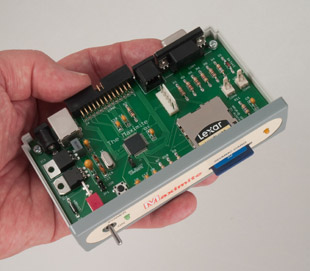
In terms of capabilities, it is slightly more powerful than Radio 86RK and the classic Spectrum. But his peripherals are fabulous: SD / FAT card, USB, VGA, PS / 2, timers, RS232, I2C, SPI, PWM, ADC / DAC and just single-purpose general purpose pins.
If you collect on the breadboard, the price will be, according to the author, less than ten Australian dollars.
The project is completely open. The author gives the scheme, the source code of the firmware and recommendations for commissioning.
Even if you quickly scroll through the documentation, obviously, the possibilities of a breakthrough. You can practically create anything mini-controllers on your knee. Work with all of the above peripherals is conducted directly from BASIC.
Programs and data can be stored on an SD card. If there is an “AUTORUN.BAS” file on the card, the firmware will automatically launch it at startup.
I liked it all, but I was too lazy to solder. And on the Internet only designers were sold.
As a result, I ordered the designer from Altronics .
And so he came. Only the microprocessor is sealed on the board, because to solder such a case, you must either have a soldering station, or a great skill.
Go.

Here I already soldered several elements. I'm not completely new to soldering, but I held the soldering iron in my hands the last time about five years ago. I had no acid, so to speed up the process, I painted rosin directly on the soldering points. The effect is about the same. Soldering iron (the one in the plate) with a sharp sting.
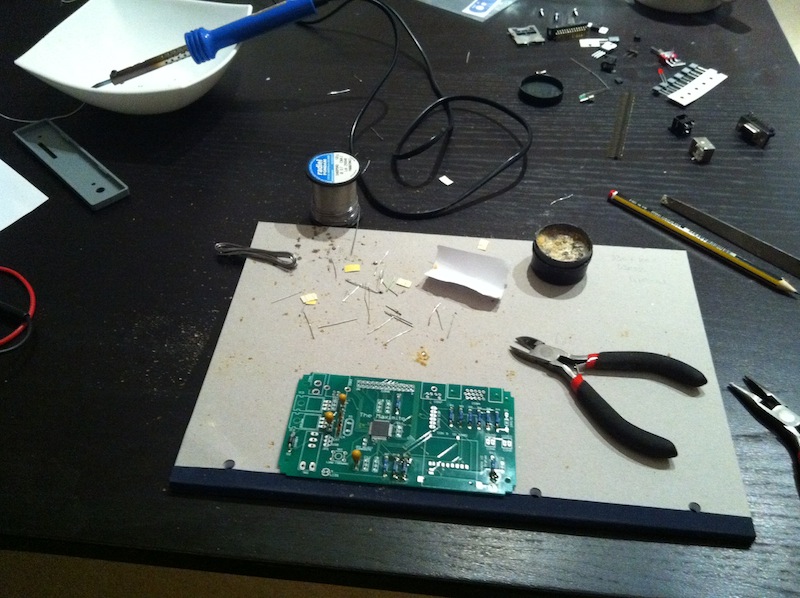
The first hour I was busy with a few elements, but then things got better.
Here half is ready.

But an hour later everything was ready.


Maximite can be powered either from external 9 volts, or from USB. I connected in the second way.
So, the launch. We connect USB and VGA to the monitor. Works!

BASIC is ready to execute commands, but there is no keyboard yet. I didn’t have a pure PS / 2 keyboard, so I tried using the USB-PS / 2 adapter. Alas, it was not possible to stick.

The next day, I took the old PS / 2 keyboard from our IT specialists and connected.
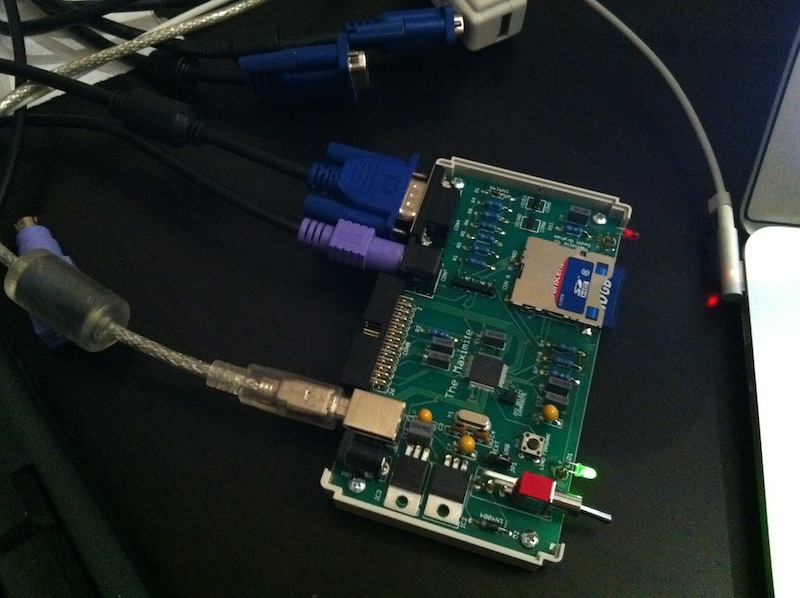
Body.
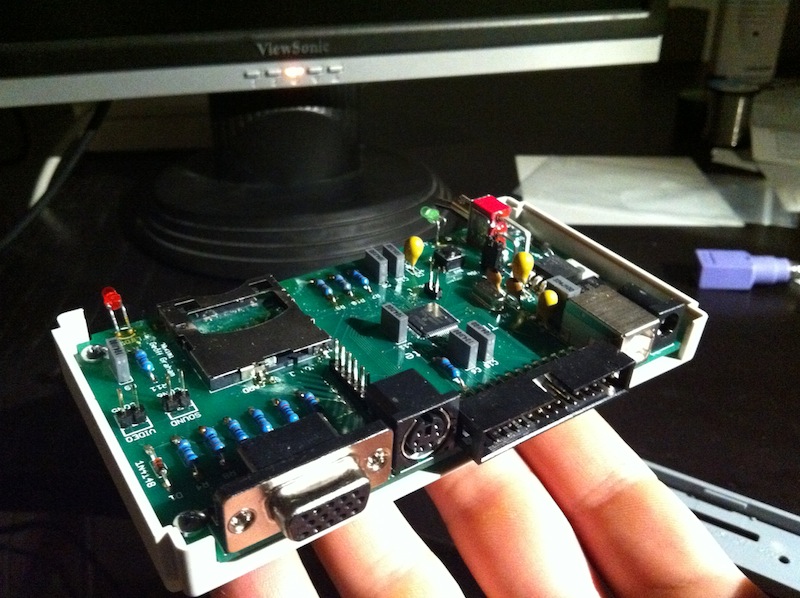

In closed form.
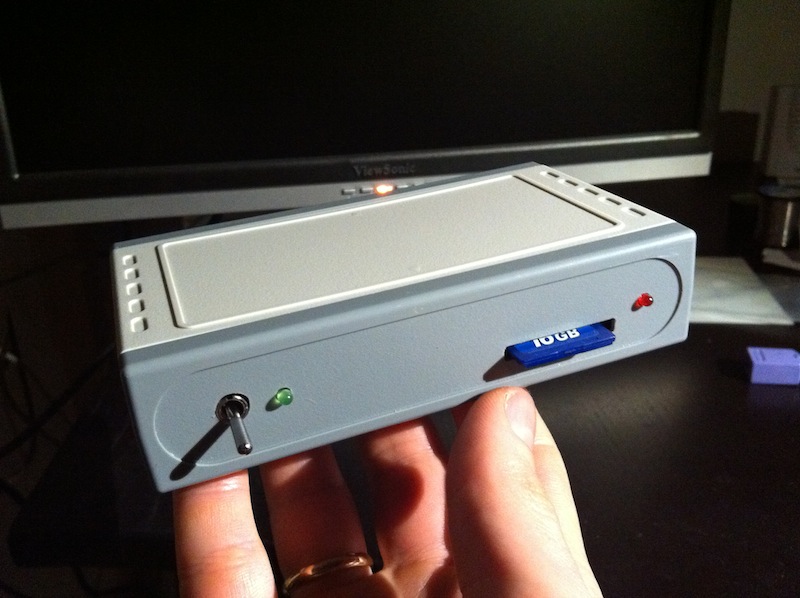
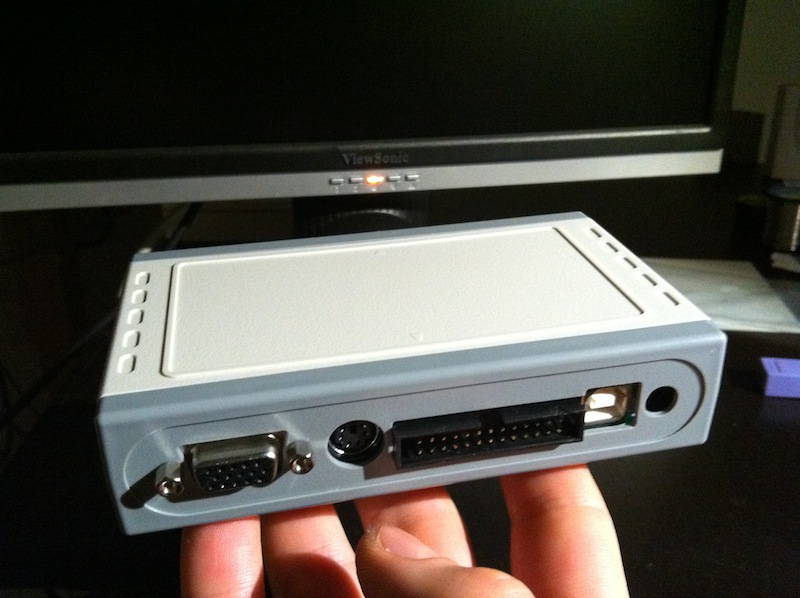
We must pay tribute - the designer from Altronics is of excellent quality. The holes on the board are metallized, which greatly simplifies soldering. The case is instantly assembled.
Now it was necessary to update the firmware, since the author of the project had already managed to significantly improve it since the release of the designer.
Maximite has a built-in ability to update firmware, and a special programmer is not needed. It is necessary to open the case and restart Maximite, holding a special micro-switch. The device enters the boot loader state, and a special utility via USB can be used to upload the update.
Maximite is seen in the USB subsystem as a standard CDC device. But for Windows, you still need to first install the driver to create a virtual COM port. On the Mac, this driver is built-in.
We connect.
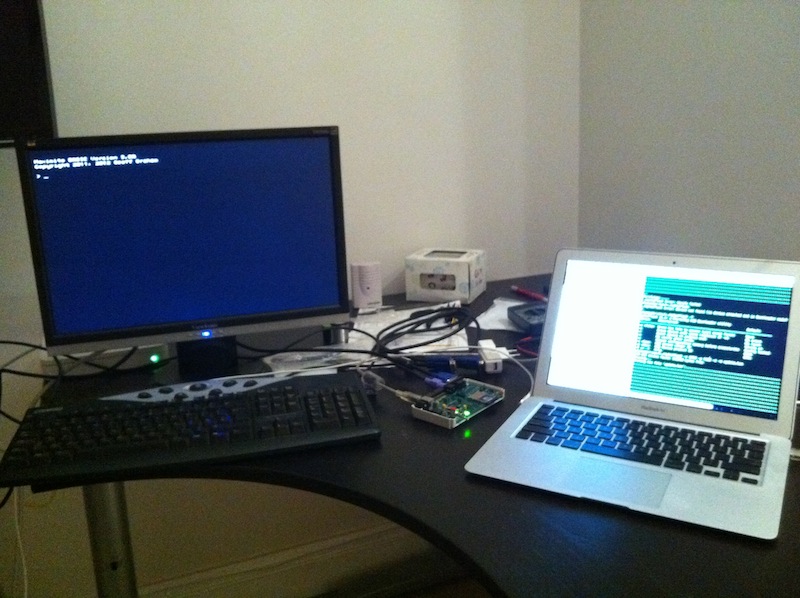
Fill it.

Hooray. Firmware updated from 2.1 to latest 3.0A.
As I said, Maximite supports VGA for display and PS / 2 for keyboard. But that's not all. If you connect Maximite via USB to a computer, in addition to power, you can run the terminal emulator program, which through the virtual RS232 port (working via USB) can exchange data with Maximite. Everything that Maximite outputs to VGA is also duplicated to the port, and everything that Maximite receives from the port is regarded as received from the keyboard.
That is, you can completely disable VGA and PS / 2 and work cleanly through the terminal. This is a drop dead opportunity.
For example, a picture from VGA (voltmeter):

And at the same time from the terminal screen:

Funny, the Maximite screen works with dots, not familiarity. When a symbol is displayed on the screen, it is duplicated, as I said, in the terminal. And if graphics are drawn, then, of course, it is not visible in the terminal.
The BASIC dialect in Maximite is a little unusual, but it gives access to the entire periphery without restriction, moreover, directly by language operators.
The author’s site has an archive with BASIC programs that demonstrate some of Maximite’s capabilities.
I will give some pictures.
Clock.

Symbol Generator Editor.

Voltmeter.

A couple of puzzles.

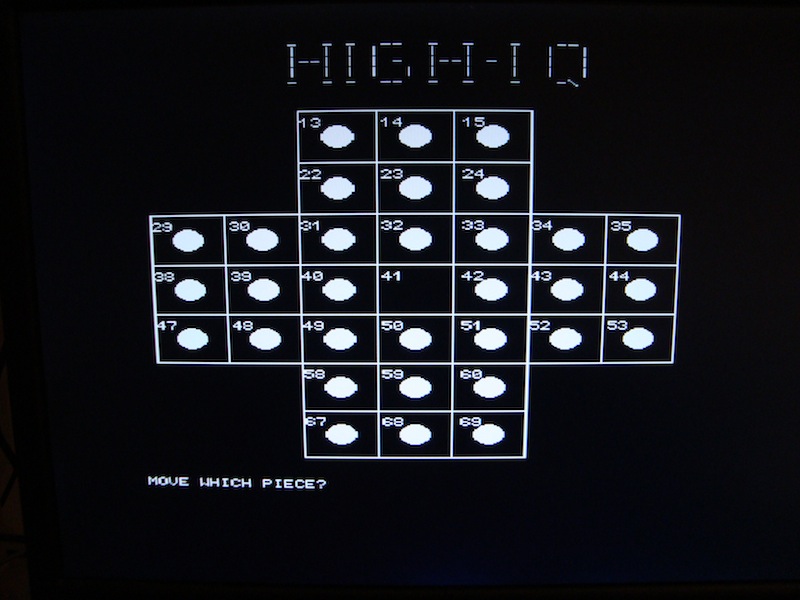
And what, I think, is not necessary to explain.
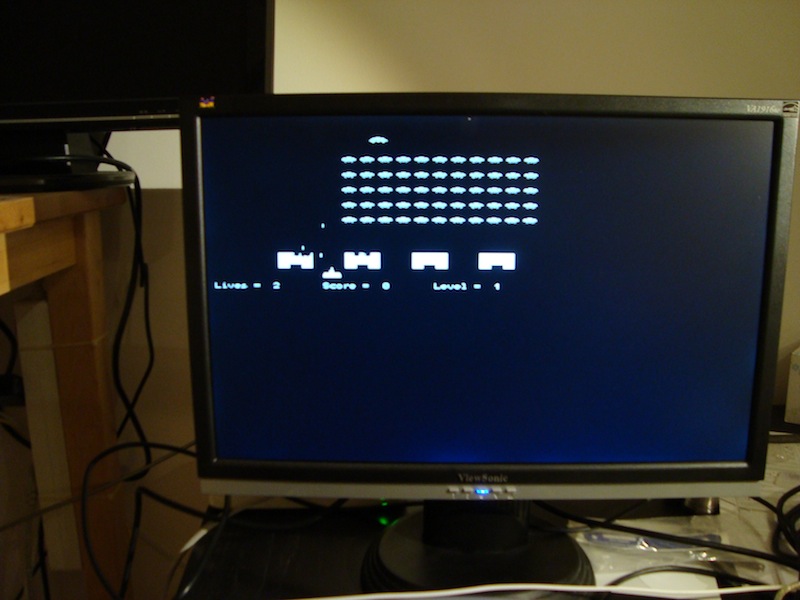

Well, of course, hello Habr!

Conclusion
Every penny I spent on this experiment was worth the buzz.
The Maximite project itself is surprising in its completeness. Everything is somehow very organic and simple. And most importantly - it works!
It seems to me - for beginners, even children interested in microprocessor technology, Maximite is just a godsend. Elementary assembly that does not require configuration. I, as a complete amateur, gathered everything in a few hours.
When my brother collected Radio 86RK about twenty years ago и Спектрум, ходила шутка про устройства для самостоятельной сборки, описываемые в журнале «Радио» — если авторы говорят, что устройство не требует наладки, то значит есть хотя бы минимальный шанс его наладить, ну я если авторы говорят, что требуется минимальная наладка…
В общем, хотите тряхнуть восьмибитной стариной с паяльником в рукам — соберите Maximite.
This is a Microchip PIC32-based microcomputer with integrated BASIC. The beauty here is that you can assemble it in a couple of hours.

In terms of capabilities, it is slightly more powerful than Radio 86RK and the classic Spectrum. But his peripherals are fabulous: SD / FAT card, USB, VGA, PS / 2, timers, RS232, I2C, SPI, PWM, ADC / DAC and just single-purpose general purpose pins.
If you collect on the breadboard, the price will be, according to the author, less than ten Australian dollars.
The project is completely open. The author gives the scheme, the source code of the firmware and recommendations for commissioning.
Even if you quickly scroll through the documentation, obviously, the possibilities of a breakthrough. You can practically create anything mini-controllers on your knee. Work with all of the above peripherals is conducted directly from BASIC.
Programs and data can be stored on an SD card. If there is an “AUTORUN.BAS” file on the card, the firmware will automatically launch it at startup.
I liked it all, but I was too lazy to solder. And on the Internet only designers were sold.
As a result, I ordered the designer from Altronics .
And so he came. Only the microprocessor is sealed on the board, because to solder such a case, you must either have a soldering station, or a great skill.
Go.

Here I already soldered several elements. I'm not completely new to soldering, but I held the soldering iron in my hands the last time about five years ago. I had no acid, so to speed up the process, I painted rosin directly on the soldering points. The effect is about the same. Soldering iron (the one in the plate) with a sharp sting.

The first hour I was busy with a few elements, but then things got better.
Here half is ready.

But an hour later everything was ready.


Maximite can be powered either from external 9 volts, or from USB. I connected in the second way.
So, the launch. We connect USB and VGA to the monitor. Works!

BASIC is ready to execute commands, but there is no keyboard yet. I didn’t have a pure PS / 2 keyboard, so I tried using the USB-PS / 2 adapter. Alas, it was not possible to stick.

The next day, I took the old PS / 2 keyboard from our IT specialists and connected.

Body.


In closed form.


We must pay tribute - the designer from Altronics is of excellent quality. The holes on the board are metallized, which greatly simplifies soldering. The case is instantly assembled.
Now it was necessary to update the firmware, since the author of the project had already managed to significantly improve it since the release of the designer.
Maximite has a built-in ability to update firmware, and a special programmer is not needed. It is necessary to open the case and restart Maximite, holding a special micro-switch. The device enters the boot loader state, and a special utility via USB can be used to upload the update.
Maximite is seen in the USB subsystem as a standard CDC device. But for Windows, you still need to first install the driver to create a virtual COM port. On the Mac, this driver is built-in.
We connect.

Fill it.

Hooray. Firmware updated from 2.1 to latest 3.0A.
As I said, Maximite supports VGA for display and PS / 2 for keyboard. But that's not all. If you connect Maximite via USB to a computer, in addition to power, you can run the terminal emulator program, which through the virtual RS232 port (working via USB) can exchange data with Maximite. Everything that Maximite outputs to VGA is also duplicated to the port, and everything that Maximite receives from the port is regarded as received from the keyboard.
That is, you can completely disable VGA and PS / 2 and work cleanly through the terminal. This is a drop dead opportunity.
For example, a picture from VGA (voltmeter):

And at the same time from the terminal screen:

Funny, the Maximite screen works with dots, not familiarity. When a symbol is displayed on the screen, it is duplicated, as I said, in the terminal. And if graphics are drawn, then, of course, it is not visible in the terminal.
The BASIC dialect in Maximite is a little unusual, but it gives access to the entire periphery without restriction, moreover, directly by language operators.
The author’s site has an archive with BASIC programs that demonstrate some of Maximite’s capabilities.
I will give some pictures.
Clock.

Symbol Generator Editor.

Voltmeter.

A couple of puzzles.


And what, I think, is not necessary to explain.


Well, of course, hello Habr!

Conclusion
Every penny I spent on this experiment was worth the buzz.
The Maximite project itself is surprising in its completeness. Everything is somehow very organic and simple. And most importantly - it works!
It seems to me - for beginners, even children interested in microprocessor technology, Maximite is just a godsend. Elementary assembly that does not require configuration. I, as a complete amateur, gathered everything in a few hours.
When my brother collected Radio 86RK about twenty years ago и Спектрум, ходила шутка про устройства для самостоятельной сборки, описываемые в журнале «Радио» — если авторы говорят, что устройство не требует наладки, то значит есть хотя бы минимальный шанс его наладить, ну я если авторы говорят, что требуется минимальная наладка…
В общем, хотите тряхнуть восьмибитной стариной с паяльником в рукам — соберите Maximite.
